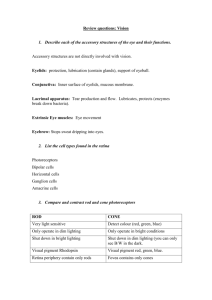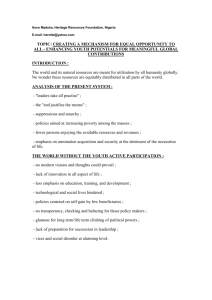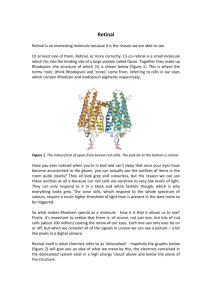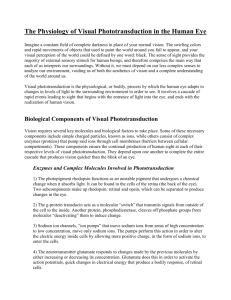Lect3_Vision_2_revised_2010
advertisement
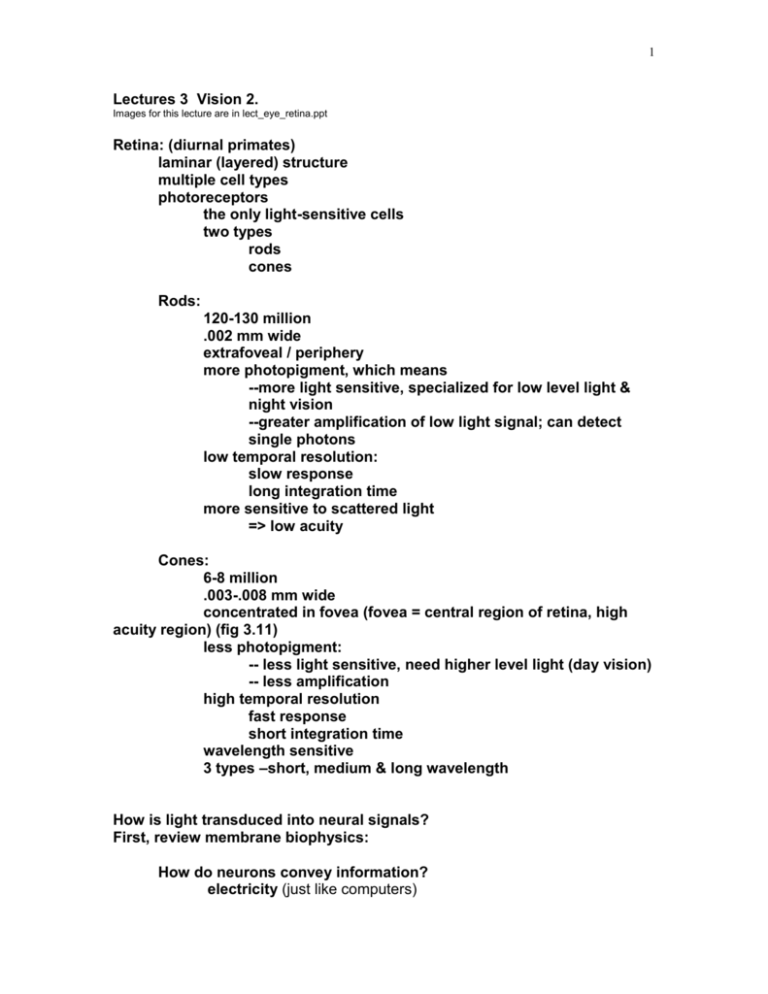
1 Lectures 3 Vision 2. Images for this lecture are in lect_eye_retina.ppt Retina: (diurnal primates) laminar (layered) structure multiple cell types photoreceptors the only light-sensitive cells two types rods cones Rods: 120-130 million .002 mm wide extrafoveal / periphery more photopigment, which means --more light sensitive, specialized for low level light & night vision --greater amplification of low light signal; can detect single photons low temporal resolution: slow response long integration time more sensitive to scattered light => low acuity Cones: 6-8 million .003-.008 mm wide concentrated in fovea (fovea = central region of retina, high acuity region) (fig 3.11) less photopigment: -- less light sensitive, need higher level light (day vision) -- less amplification high temporal resolution fast response short integration time wavelength sensitive 3 types –short, medium & long wavelength How is light transduced into neural signals? First, review membrane biophysics: How do neurons convey information? electricity (just like computers) 2 How do we know this? Can make very small electrodes that can actually be inserted inside neurons. Measure voltage. Electrode = any kind of conductive element. Can be as simple as the exposed tip of an insulated wire. Neuroscientists also make electrodes out of glass micropipets. Make a very tiny tip on the micropipette, fill with conductive fluid, hook up to an amplifier with a wire, and you've got yourself an electrode. Electrodes of this kind can actually be inserted into neurons. (draw electrode in axon) Measure voltage across cell membrane ==> -70 mV All signaling results from changes in the resting membrane potential, so it is important to understand how it is produced. I’m assuming you know have learned how the resting membrane potential is generated in your previous classes. If you haven’t, I recommend reading a standard introductory neuroscience textbook. Some quick points of review, to set the stage for our purposes. If Na+ channels open, what will happen to a neuron’s potential? K+? Cl-? What if these channels close? This is important to think about because: Neural activity = deviations from this resting membrane potential. 1. Action potentials 2. Post-synaptic potentials (PSP's) / Receptor potentials Action potentials (review): Found in axons: 3 For neurons that fire action potentials, Every AP or spike is about the same size: information is encoded in the rate of occurrence of AP's Neurons are said to fire spikes, "neural activity" refers to the firing rate of neurons message = firing rate (not size of AP, or width of AP) Two other general types are graded in strength (not all-or-none): Post-synaptic potentials (review): Are generated at synapses: Found in dendrites, cell bodies (but can occur in axons) Can be either excitatory or inhibitory excitatory ==> makes the axon more likely to fire an AP inhibitory ==> makes the axon less likely to fire an AP Receptor potentials (NEW material!) -Are generated in sensory receptors like post-synaptic potentials, graded level is important not an all-or-none effect Neurons in the visual system: --------------------------------------------------------------------------------------How is light absorbed & subsequently transduced into electrical signals? rod cells contain visual pigment, rhodopsin rhodopsin absorbs photons rhodopsin molecule = combination of retinal & opsin retinal = aldehyde form of vitamin A (this is why carrots are supposed to be good for vision) retinal can have 2 different shapes bent 11-cis form binds to opsin straight all-trans form does not bind opsin Absorption of photon => converts cis to trans the only light-dependent step 4 => biochemical cascade to amplify this signal and transduce it into something electrical => uses a second messenger system 1 activated rhodopsin molecule => hundreds of phosphodiesterase molecules phosphodiesterase hydrolizes cGMP closes Na+ channels => Hyperpolarizes the cell -30 mv to -70 mV => decreased release of neurotransmitter NO ACTION POTENTIALS INVOLVED YET So, light => decreased neurotransmitter Recap: Transduction: 1. Rhodopsin (retinal + opsin) absorbs light - breaks a double bond in retinal - retinal switchs from cis to trans (then double bond reforms). - Opsin breaks off - This is the only light-dependent step 2. Biochemical cascade set in motion - involves internal second messenger (cGMP) - amplifies the signal (because enzymes can catalyze many reactions) 3. Na+ channels are closed In the dark, they are open, and cell sits at -30 mV. This is called the "dark current". Light hyperpolarizes the cells to -70 mV 4. Less neurotransmitter is released. 5 So, light => decreased neurotransmitter Retinal circuitry: Oddity of mammalian retina photoreceptors are at the back, behind all the other cell types probably not optimal (octupi are different) but no great cost - thin, transparent cell layers Other cell types & connections in the retina retina = network ( latin net = rete or reti (crossword puzzles)) rods/cones ===> bipolar cells === > retinal ganglion cells horizontal cells amacrine cells Retinal ganglion cells = first cells in pathway to fire action potentials. Implications of this circuitry for Acuity & Sensitivity: Acuity = spatial resolutin Sensitivity = detectability retinal structure reflects trade off/ Figure 3.11. extrafoveal/periphery = optimized for sensitivity - several hundred rods -> 1 bipolar = CONVERGENCE => enhanced sensitivity, but at the expense of spatial resolution (bipolar cell pools across the locations spanned by the photoreceptors) fovea = acuity - 1 cone / bipolar/RGC - maintains info about where light came from, but doesn't respond well to low levels of illumination We're not aware of the lower acuity in the periphery. So, how do we get acuity all over the visual field? By aiming the camera, i.e. moving the eyes.
